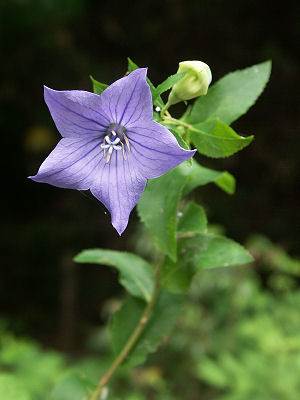Balloon flower
| Balloon flower | ||||||||||||
|---|---|---|---|---|---|---|---|---|---|---|---|---|

Balloon flower ( Platycodon grandiflorus ) |
||||||||||||
| Systematics | ||||||||||||
|
||||||||||||
| Scientific name of the genus | ||||||||||||
| Platycodon | ||||||||||||
| A.DC. | ||||||||||||
| Scientific name of the species | ||||||||||||
| Platycodon grandiflorus | ||||||||||||
| ( Jacq. ) A.DC. |
The balloon flower ( Platycodon grandiflorus , syn .: Campanula glauca Thunb. , Campanula grandiflora Jacq. (Basionym), Platycodon glaucus (Thunb.) Nakai , Platycodon grandiflorum ), also called large-flowered balloon flower or Chinese bellflower , is the only plant species of the monotypic genus Platycodon from the family of the bellflower family (Campanulaceae). The German name comes from the fact that the flower buds inflate before they open.
description
Platycodon grandiflorus grows as a branchy, perennial, herbaceous plant and reaches heights of 50 to 70 cm. Tap roots are formed. The blue-green, sharply toothed leaves are overgrown with slightly whitish and oval-lanceolate; the lower ones are 2.5 to 3.4 cm long and 2 to 3 cm wide.
There are zymöse inflorescences formed. The mostly five-fold flowers have a diameter of 5 to 7 cm. The blue to rarely white petals are broadly fused bell-shaped. There is only one stamen circle with five stamens . Flowering time is from July to August.
The egg-shaped capsule fruit contains egg-shaped, compressed, first purple and later brown seeds.
The number of chromosomes is (n = 18) 2n = 36.
Occurrence
The home of the balloon flower is in Northeast Asia in China , eastern Siberia , Mongolia , Korea and Japan . In some other areas this species is wild.
Preferred locations are dry grass and stony soils between bushes or in forest clearings.

R 2 = different alkyl residues .
Use and pharmacological properties
Varieties of this type are used as conditionally hardy ornamental plants . A number of varieties with different flower colors and sizes have been bred.
Their roots (radix Platycodi) are in the traditional Chinese and Korean medicine and Korean cuisine (kor. Doraji used) for immune stimulation and cancer. In animal experiments, extracts from the plant increase the activity of B cells and cytokine production. Saponins from the root (Platycodin AE) show anti-inflammatory effects in the laboratory. It is also grown as an ornamental plant.
Only young leaves are eaten cooked; it is said that the older leaves are poisonous. Older leaves are dried and used as a spice. Roots are eaten cooked in soups as a fortifying vegetable. The roots are also peeled and soured or preserved in sugar. Especially in Korean cuisine, the roots appear as "bellflower roots".
The roots are often referred to as poisonous in their raw state.
Web links
- Description of the species at eFLORAS. (engl.)
- Characteristics. ( Memento from September 11, 2004 in the Internet Archive )
- Entry at usda.gov
Individual evidence
- ↑ Platycodon grandiflorus in the Germplasm Resources Information Network (GRIN), USDA , ARS , National Genetic Resources Program. National Germplasm Resources Laboratory, Beltsville, Maryland.
- ↑ Rafaël Govaerts (ed.): Platycodon. In: World Checklist of Selected Plant Families (WCSP) - The Board of Trustees of the Royal Botanic Gardens, Kew . Retrieved February 12, 2018.
- ↑ CYChoi et al .: augmentation of macrophage functions by at wässrige extract isolated from Platycodon grandiflorum. Cancer Lett . 166/1/2001. Pp. 17-25. PMID 11295282
- ↑ Kwang Seok Ahn et al .: Inhibition of inducible nitric oxide synthase and cyclooxygenase II by Platycodon grandiflorum saponins via suppression of nuclear factor-KB activation in RAW 264.7 cells. Life sciences . 2005/76/20. Pp. 2315-2328.
- ↑ Entry in Plants for a Future.
- ↑ URBAN HERBS: Medicinal Plants at Georgetown University, Balloonflowers ( Memento from January 22, 2013 in the Internet Archive )




